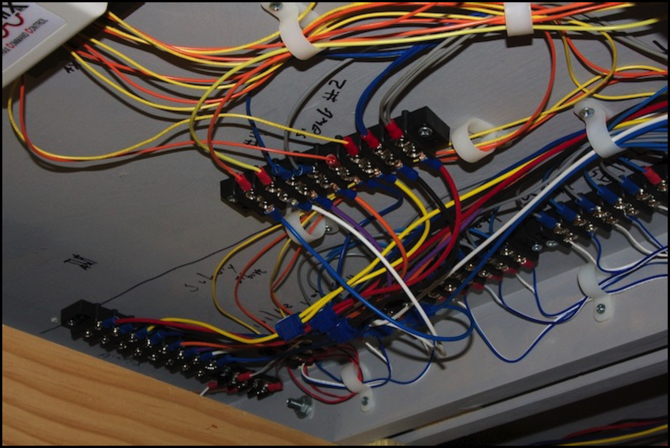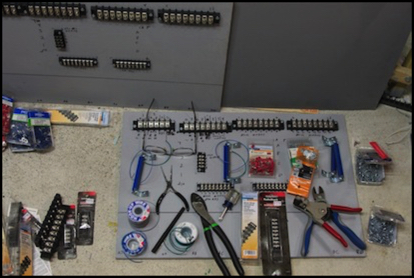More Wires

After saying I was going to finish up the DCC electronics several times, I’ve finally made a start. There are two parts to this. The first is finishing up the remaining DCC power protection and occupancy detector panels. I did the first three tables last year, starting around January. The third was the first I’d done as a removable panel, which I wired up back in November. At the same time I’d begun the work of setting up a third accessory power bus, adding a switch and meter to the main panel. However at that point I’d stalled, with my attention off the layout over the holidays, and when I returned it was to work on buildings.
But now I’ve started construction of the final three DCC panels. These are essentially clones of the one I did in November, so they should go fairly quickly. There’s a lot of soldering involved, which is what put me off starting, and which will take the most time. But I’m working on all three in parallel, so I can’t stop after finishing one or two and say “later”. This time I’m pushing through to the end. I’m going to have a fully DCC layout if it kills me (and after this evening’s work, it might; I’m too old and inflexible to work on the underside of a model railroad :-) ).

Two of the new DCC panels under construction
And that’s the other part: finishing up the new power bus. Right now I have two accessory power bus wire pairs under the table, the front blue/yellow set provides power to the BDL168 Occupancy Detectors and future SE8C Signal Controller. The rear blue/yellow set provides power to the DS64 Turnout Controllers and various things like the fast clock display and UR92 throttle radio receiver. I need a third because I decided to separate the PM42 from both the occupancy detectors (which are sensitive) and the general accessory power bus, which is going to be driven off a 5 Amp output from the main PS2012 supply, and since that also provides track power the PM42 can’t share it. The new one will be color-coded blue/white to keep it separate from the blue/yellow set and because it’s unlikely to be confused with the blue/white track feeders given the location and wire size.
The problem with this is that I need to replace the six-position rear terminal strips with eight-position ones. This involves removing all wires and the old strip (doing one at a time) and replacing it with the new one. And then adding the new wire and relocating the existing accessory wiring as needed. All done upside down with poor lighting and worse leverage. Each table has three strips to redo (two ends and the drop strip in the middle). The first table took about an hour and a half, which is a large part of one evening’s work time. I have five of these, plus some additional wires. It’s going to be a while.
One of my take-aways from all of this: in my hypothetical next layout, the bus wires and related terminal strips will go on the wall or other backing, where I can comfortably reach them while sitting on the floor or a stool. And I’m going to say the heck with Digitrax, and buy DCC gear from anyone who doesn’t use soldered connections (I want screw terminals or similar). Track feeder strips should also go on the back wall, where they can be reached.
But I’ve started. The photo at the top of the page shows the first table’s drop strip (center) and one end strip (left), as well as a bunch of feeders (top right) and one of the DS64 controllers with its outputs (most of the yellow/orange wires, although I also used yellow/orange for the power lines to accessories; I ran out of different colors).
I’ve updated several pages in the Electrical Systems subsection of The Model Railroad section. In part this was so I’d have it online to use as a reference when working under the table. I keep my iPad to hand, with a number of bookmarks to this website in the browser, when doing under-table wiring. I also keep instruction manuals in PDF form for all of the electronics on the iPad, which has turned out to be much more convenient than hauling around a stack of the paper manuals.



